Chapter 2: Conflicts over Religious Pluralism
The uprising against Christianity stemmed from practices and doctrines like :-
- Indulgences: a practice that had come to mean the buying of forgiveness for sin.
- Papal infallibility: —the belief that the word of the pope is supreme on matters of faith.
The concerns over these practices fractured the religious unity in Central and Western Europe, , bringing the emergence of differing and often competing sects of Christianity in the 16th century, a religious revolution known as the Reformation.
Reforms in the Christian Church
The desire for art and material wealth caused the Church to be a patron for painters such as Michelangelo and to build grand cathedrals. Thus, in the view of the reformers, many Church officials , especially the high clergy, had turned away from true religious responsibilities. In response to this and other practices, Christian Humanists called for religious reform.
Christian Humanists Seek Religious Reform
- Christian Humanists in Northern Europe wanted to use their intellectual achievements and love of the classics to ==inspire Christian beliefs==.
- They were critical of the growing ==secular spirit== of the Church
- They wanted to restore what they considered a ==purer Christian dogma==
- They embraced the motto “Ad fontes (back to the source)”
- They began reading Bibles in Greek and Hebrew
- They also began ==studying writings of early Christian beliefs==
Some of the representatives of Christian Humanists are
Desiderius Erasmus:
- Dutch scholar
- He acquired traditional scholastic education as well as a new liberal arts education at the University of Paris
- He called for the reading of the New Testament in Greek, Latin, and Hebrew in order to understand its original meaning.
- He began writing extensively about the need for reform.
- One of his writings, %%In Praise of Folly%% %%,%% addresses
==i.== Church abuses such as the lack of knowledge among much of the clergy==ii.== The focus of the papacy on material rather than spiritual concerns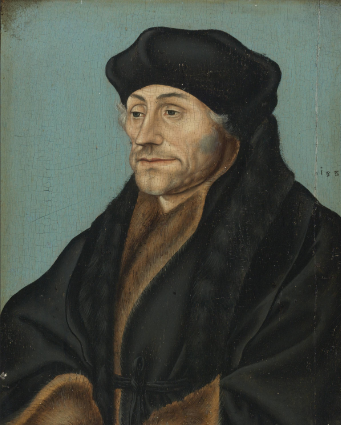
Thomas More
- English Christian Humanist
- Close friend of Erasmus’s
- studied at the University of Oxford which helped him gain government positions such as a member of Parliament and adviser to Henry VIII, king of England.
- In 1516, More wrote the book @@Utopia@@
The book Utopia is about an imaginary land that possessed ==a perfect, orderly society==. This tells us about his will to @@create a more just society@@, %%favoring education for women%% and %%the abolition of private property.%%
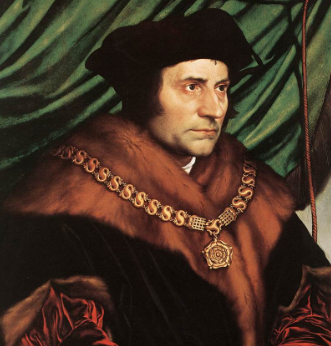
Martin Luther Establishes New Doctrine
- Martin Luther had attended a school run by the Brethren of the Common Life, %%a group that taught Christian Humanism.%%
- He later attended the %%University of Erfurt%%, receiving a strong %%liberal arts education.%%
- Embraced the slogan “Back to the source”
- After earning a master’s degree, Luther entered an Augustinian Monastery, where he continue his studies and arrived at his belief in “Sola Fide” - ==People gained eternal salvation “by faith alone”==
- ==God’s grace== is the only way to acquire salvation and no other actions are required to be performed by the people. To Luther, good works like attending church and helping poor were the result of faith, not steps on a path to eternal life.
Luther argued that any religious practices encouraging the belief that good works alone led to salvation were misleading.
Luther presented his document known as 95 Theses after Pope Leo X proclaimed a Jubilee Indulgence to raise money for the restoration of St. Peter’s Basilica.
The most famous indulgence preacher was ==Johann Tetzel==. He was hired to sell indulgences in the German states of the Holy Roman Empire.
. According to legend, Tetzel said, ==“As soon as the gold in the casket rings, the rescued soul to heaven springs.”== In response, according to legend, an angry Luther nailed the his theses to the door of the Wittenberg church, denouncing indulgences and other Church practices.
More likely, according to the custom of the time, Luther simply wanted @@to prompt his archbishop@@ and @@other scholars@@ to @@discuss possible reforms@@ within the Catholic Church. But as a result of the printing press, within months his document was circulating throughout Europe. Luther, an unknown monk, quickly became the key figure of a rapidly growing protest movement.
Luther and other reformers objected to the following issues:-
• Simony: the buying and selling of Church appointments and offices
• Pluralism: the holding of multiple Church positions at the same time
• Nepotism: the appointment of family and friends to Church positions
• Immorality: the decline in moral standards of clergy and monks
• Indulgences: a practice that had come to mean the buying of forgiveness for sin.
The Catholic Church Response
Catholic officials ==responded forcefully== accusing Luther of @@heresy@@
In 1518, after being allowed to defend his position in a debate in the imperial city @@(A city which is subject only to the authority of the emperor)@@ of Augsburg, the Church ordered Luther to recant his protests.
Luther refused and returned to Wittenburg .
The pope issued a decree demanding that Luther recant or be excommunicated—exiled from the Catholic Church.
In %%April 1521%%, Luther appeared before a diet, or assembly of leaders, that convened in the @@city of Worms@@ with the choice to either recant or affirm his beliefs.
He @@refused to recant@@. The Catholic Church excommunicated Luther, and Charles V (newly chosen emperor of the Holy Roman Empire) declared him an %%“outlaw of the empire.”%%
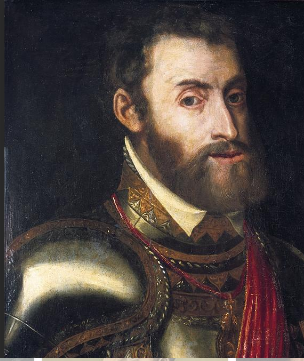
” Protestant Doctrines and Practices”
- Religious dissent meant death but Luther was strong and took courage, he was also supported by many German rulers.
- ==Reason for getting support from German rulers:== ==Some cared about the theology but most hoped that the religious controversy would help them to reduce Rome’s political power.==
- Luther’s prince, ==Frederick III of Saxony==, protected him in the prince’s castle known as the @@Wartburg@@. There, Luther began to work out his ideas more fully.
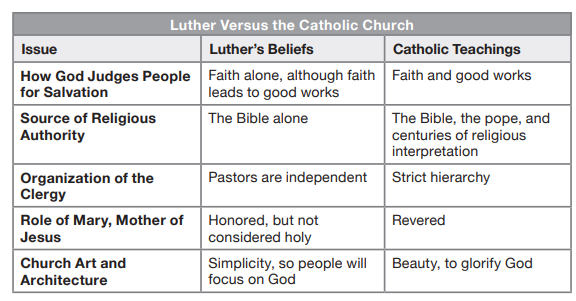
Zwingli and Calvin Bring New Interpretations
- Even before Luther challenged the Catholic Church, the group of states known as the Swiss Confederation sought independence from the leaders of the Catholic Church and the Holy Roman Empire.
In 1499, the Swiss Confederation won enough autonomy %%to allow Swiss merchants%% and %%crafts workers%% to flourish ==economically== and ==politically==.
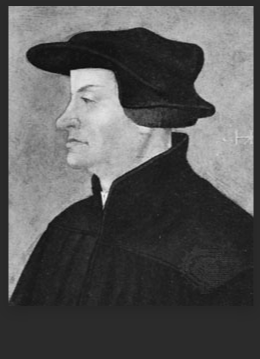
In 1519, Huldrych Zwingli
A pastor of the People’s Church in Zurich
He began criticizing the Catholic Church and its abuse of power after reading Erasmus’ texts.
Following Luther’s footsteps, Zwingli Zwingli criticized ==the papal authority and clerical celibacy==, or a%%bstaining from marriage and sexual relations.%%
He demanded a simplified service based on the principle of “faith alone” .
He challenged both Luther and the Catholic Church on the necessity of sacraments ^^(rites such as communion, believed to be a way to attain divine grace)^^
Bread and wine of the communion
“ Luther believed that the communion’s bread and wine were both bread and wine and the body and blood of Christ (consubstantiation). In the traditional Catholic belief, the bread and wine of communion actually became the body and blood of Christ (transubstantiation).”
Zwingli rejected both beliefs.
The Marburg Colloquy: %%The Protestant leader Philip of Hesse invited Luther and Zwingli to discuss their disputes and unite Protestants. The two disagreed, thus permanently dividing Protestants.%%
Zwingli insisted abolishing the spiritual necessity of ritual sacraments, such as baptism, confirmation and penance.
- Baptism : the Christian religious rite of sprinkling water on to a person's forehead or of immersing them in water, symbolizing purification or regeneration and admission to the Christian Church
- Confirmation : the rite at which a baptized person, especially one baptized as an infant, affirms Christian belief and is admitted as a full member of the Church.
- Penance : a sacrament in which a member of the Church confesses sins to a priest and is given absolution.
Calvinism in Switzerland
- In 1536, a French- born theologian John Calvin published his book “Institutes of the Christian Religion, calling for religious and political reforms.
- He had studied the ideas of Luther and other dissidents, and he agreed with many of their criticisms of the Catholic Church**.**
- He developed two new ideas
- Predestination: Calvin believed that an ==omnipotent (all-knowing) God already knew who would be saved and that, even at birth, a person’s eternal fate was set.==
- Concept of the elect: those chosen by God to be saved, their behavior would be an outward sign that such people were part of the elect, and their accumulation of wealth would be another sign of God’s favor.
The leaders of Swiss city, Geneva, invited him to live and preach.
In Geneva, Calvin’s doctrines transformed not only the practice of Christianity but also the role of the government
- The Bible served as the highest law in Geneva
- Sinning was a civil offense.
- The city required residents to denounce the Catholic faith
- People who failed to follow the religious laws could be forced to leave the city
- While laws enforced religious practices, they also required churches to provide social services for the city’s poor and sick
Anabaptists Reject the Secular World
- Unlike Catholics, Lutherans, and Calvinists, Anabaptists rejected baptism of infants.
- In 1525, another Protestantism emerged in Zurich called Anabaptists.
Anabaptists’ ideology :
- They rejected baptism of infants.
- They stressed that only adults could make decisions to believe
- They required all adults to be rebaptized.
- They excluded themselves from the society because they believed that sin existed everywhere.
- They refused to serve in the government and the military.
Due to their seclusion policies, they were in @@direct@@ @@conflict with the government@@ and due to their %%unique doctrine and solitary lifestyle%%, both Catholics and Protestants targeted them too.
Division Among European Christians
The Reformation caused the Catholic Church to reflect ==on its doctrines and policies==. While the Church mostly ==reinforced its established belief system==, it also made some changes. This period of change is known as the Counter Reformation or the Catholic Reformation.
- During the Middle Ages, the Catholic Church had %%established several institutions%%, known together as the Inquisitions.
- The Inquisition searched for and punished heretics, Christians who denied important Church doctrines.
- In 1542, the pope introduced the ^^Roman Inquisition^^ to stop Catholics from %%converting to Protestantism%%.
Steps taken to stop the spread of Protestantism:
- In 1542, the Pope introduced the Roman inquisition
- The pope established the Index of Prohibited Books
- To promote the unity of the Catholic faith, Pope Paul III convened the Council of Trent.
Index of Prohibited Books: A list of books that Catholic printers were not to print and Catholics were not to read.
The Catholic response to the Reformation:-
- Included establishment of new religious orders.
- Each order had its own focus.
- Eg: @@Jesuits in 1540 (est. by Ignatius Loyola) and the Ursuline Sisters in 1544.@@
Example: The formation of Jesuits
- An order that emphasized obedience to authority, prayer, and communal living.
- They ^^provided soldiers to fight Protestants^^ and missionaries ^^to spread Christianity^^ in the Americas and East Asia.
- They became %%famous for their rigorous scholarship%%. Many of the most prestigious universities in Europe %%were founded by Jesuits%%.
- This ^^commitment to research^^ and ^^learning^^ would later bring them into conflict with Roman Catholics who ^^disliked their willingness to question traditional teachings.^^
Council of Trent
Pope Paul III convened the Council of Trent
The council was responsible for %%reaffirming traditional%% Catholic doctrine while addressing issues such as %%clerical pluralism%% and %%simony%%
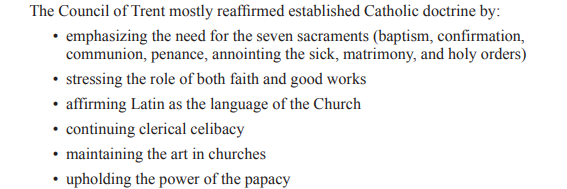
The actions of the Catholic Reformation ==revived Catholicism==, particularly in @@Southern and Central Europe@@, in what are today the countries of ^^Spain, Italy, and Austria.^^
%%State Power and Religion%%
In some places, leaders and religious groups used the religious changes of the Reformation to promote political unity. In others, such changes led to partisan turmoil and challenges to a leader’s authority.
^^Top Down^^ Religious Reform in England
^^In England, reform started at the top. The king of England changed the religious practice of his subjects by edicts and laws.^^
- %%Henry VIII defends Catholicism:-%%
- In 1509, Henry VIII assumed the throne of England. (ruled for 38 years)
- He became one of England’s most influential monarchs.
- When Martin Luther began criticizing the Catholic Church, Henry VIII quickly came to the support of Pope Leo X. Henry VIII, with the help of his trusted advisor Thomas More, argued in favor of ^^the supremacy of the pope^^ and the ^^importance of the sacraments^^.
- The pope gave Henry VIII the title ==“Defender of the Faith” ==
- \
- Without a clear male heir, %%Henry VIII feared for the stability of the Tudor Dynasty%% after his death, especially since he was only the second Tudor king.
Marriage crisis of Katherine and Henry VIII
He ended his marriage to Katherine of Aragon after 20 years of marriage.
He asked ^^Pope Clement VII for an annulment, or cancellation^^, of his marriage on the grounds that it should ^^never have been allowed.^^
Katherine had been ^^married to Henry’s brother^^ before he died, and Henry argued that ^^his marriage to her was improper.^^
The pope, ^^pressured by Charles V^^ and unwilling to offend Spain’s Catholics, ^^refused to grant the annulment.^^
In ^^1533, Anne Boleyn^^ became pregnant and then gave birth to Elizabeth. another female. Henry VIII divorced Katherine and married Anne Boleyn.
But ^^Pope Clement VII^^ declared Henry and Anne’s marriage illegal.
Under Henry, Anne Boleyn was ^^executed for adultery^^.
Henry VIII responded by denouncing the authority of the pope.
In Nov 1534, the English Parliament %%passed the Act of Supremacy,%% making the king of England the head of the Church of England.
- England was %%no longer officially a Catholic country%%
- He later married ==Jane Seymour,== who finally presented Henry with a son, ^^Edward Seymour^^ died shortly after giving birth, and Henry married three more times but had no more children.
Katherine of Aragon : The youngest daughter of Ferdinand and Isabella of Spain and the aunt of Holy Roman Emperor Charles V.
Anne Boleyn: The mistress of Henry VIII
To enhance his powers, Henry VIII enacted additional religious reforms:-
- The Treason Act: Refusal to recognize the Church of England as the state religion an act of treason. Violating this act was punishable by death.
Transformation of Church in England:-
- The Church of England became known as ^^the Anglican Church.^^
- . Anglicans did not all agree with how closely they should keep to Catholic traditions and doctrine
- High Church: Those who wanted to remain close to the Catholics.
- Low Church : Those who were more influenced by Protestant doctrines and practices were known as “Low Church.”
Two Brief Reigns
Following Henry’s death, his young son Edward became king. He reigned for only six years (1547–1553) before dying at 15. During these years, the government became more Low Church.
However, his successor, ==Mary Tudor== (reigned 1553–1558), took the country in the opposite direction:
- She tried to restore Catholicism to England.
- Those in England who had never supported the break with Rome supported her, as did her powerful husband, the Spanish king Philip II.
- Mary’s persecution of some Anglican bishops earned her the nickname @@“Bloody Mary.”@@
After Mary Tudor’s death, her half-sister, ^^Elizabeth I^^
- She tried to find a middle ground, also sometimes known as the ^^Elizabeth Settlement.^^
- She returned to Anglicanism, rejecting both Roman Catholicism and strong Calvinism.
- During her long reign, she avoided harsh persecution of people who practiced their own beliefs quietly.
- Elizabeth was determined to restore the Anglican Church in England
- She wanted to prevent more radical forms of Protestantism from growing, such as the Puritans.
- Elizabeth employed diplomacy and often used marriage proposals to form alliances.
Puritans: wanted to “purify” the Church of England, ^^demanding the elimination of clerical dress^^ and r^^emoval of Catholic^^s from England
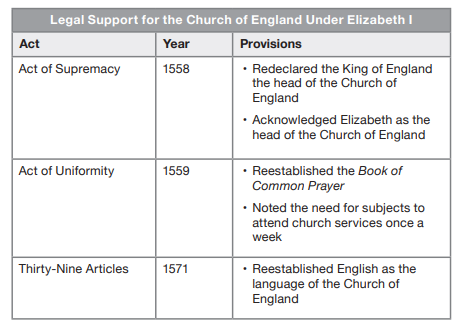
Other Monarchs Initiate Religious Reform and Control
Some loosened restrictions to allow religious pluralism. Others, such as Philip II of Spain, became strong advocates for Catholicism.
^^France’s Agreement with the Pope^^
- In France in 1516, King Francis I (reigned 1515–1547) signed the Concordat of Bologna with Pope Leo X
- Concordat of Bologna: the Catholic Church continued to collect income from French churches.
- In return, the king gained the ^^power to tax^^ the clergy and %%appoint Catholic bishops%% ^^i^^n France. Because the king created such a powerful relationship with the Catholic Church, the Reformation initially had a limited impact on France.
^^The Holy Roman Emperor Implements Peace^^
- By the reign of Holy Roman Emperor Charles V (reigned 1506–1556), the Habsburg Dynasty encompassed a large landmass throughout Europe and the Americas.
- Charles had to spend much of his rule confronting the expansion of the Ottoman Empire.
- These concerns prevented him from dealing more forcefully with Lutheranism, and by the time he tried to do so, it had become too entrenched.
- In 1555, Charles established the Peace of Augsburg in the German states, a legal agreement ==allowing each German ruler to determine whether residents of that state== would be Catholic or Lutheran. ==The faith of the ruler would become the faith of all.==
^^Religious Challenges to Monarchical Power^^
- Martin Luther while publishing the 95 Theses had little interest in politics. But religion an politics were thoroughly intertwined in Europe during his lifetime.
- His challenges to religious authority created an environment that prompted others to challenge political authority.
Eg: In the %%German Peasant Wars of 1525 and 1526%%, farmers rebelled against the feudal power of the nobles.
Puritans Challenge the English Crown: Puritans feared he would reinvigorate Catholicism in England. As ruler, ==James was sympathetic to Catholics, but only those who publicly supported the Church of England==. James’s successor, Charles I, also worried Puritans. He married a French Catholic, Henrietta Maria, and he did not aid the Protestants in their battle against Catholics known as the %%Thirty Years’ War.%%
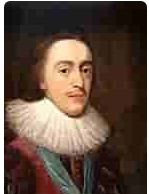
The struggle between the Puritans and the Stuart monarchy came to a head in the ==English Civil War (1642–1649)== when the %%Puritans supported the Parliamentarians%% against the Royalists. In 1649, the Parliamentarians successfully overthrew the Stuart monarchy and executed Charles I.
Conflicts among Religious Groups
The growing religious tension between %%Catholics, Lutherans, Calvinists, and Anabaptists throughout Europe,%% combined with political rivalries that often fell along religious lines, brought nearly a century of warfare. ^^Between 1562 and 1648^^, millions would be slaughtered or would die from hunger and disease related to internal rebellion, civil war and international conflicts.
- 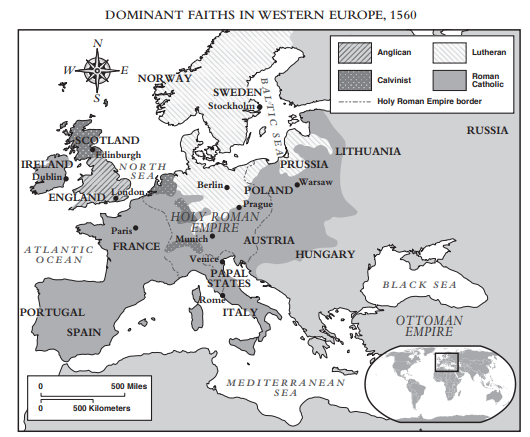
The French Wars of Religion
The Concordat of Bologna ==signed in 1516== worked for several decades, as long as nearly all French were Catholics. However, by 1562, French Calvinists, known as Huguenots, %%represented 10 percent of the country’s population, or about 2 million people.%%
Origins of the Religious Conflict: The French monarchy %%persecuted the Huguenots%% in order to diminish the power of the nobility and %%protect Catholicism.%%
- The ascension of Charles IX caused a power vacuum in which religious and political motivations, the French Wars of Religion continued to escalate leading to nine civil wars from 1562 to 1589.
Religious Violence : In 1562, after a massacre of Huguenots at Vassy, French Calvinists took to the streets and ==looted Catholic Churches==, destroying artwork and breaking stained-glass windows.
- ^^St. Bartholomew’s Day Massacre^^: At the marriage of Margaret of Valois, the sister of the king of France, to Henry of Navarre, a leading Calvinist. Henry Navarre invited many wealthy and influential Huguenots to the wedding in Paris. ==Catherine de’ Medici== in collaboration with the reactionary Catholic Guise family, ==ordered the massacre of the Huguenots, which pleased the pope and other reactionary Catholics.== Starting in Paris and spreading outward, an %%estimated 10 to 20,000%% were killed in an event.
Political Rivalry: As civil war persisted in France, three men, each named Henry, competed to be king.
- ^^Henry III of Valois^^ was a Catholic. He was the fourth son of King Henry II and supported by his mother, Queen Catherine de’ Medici, who was Italian. Henry III became king of France in 1574 after the death of Charles IX. Catherine was influential throughout his reign.
- ^^Henry of Navarre^^, the husband of %%Margaret of Valois%%, was a Huguenot with support from %%Elizabeth I of England%%. He was heir-presumptive to the throne %%after Henry III of Valois%%.
- ^^Henry of Guise^^ was a Catholic with support from @@Philip II of Spain@@. He established the @@Catholic League@@, which wanted to ensure that only Catholics ruled France.
Two Henrys were assassinated and this event was known as the %%“War of the Three Henrys”%%
In 1588, the bodyguards of Henry III killed Henry of Guise.
In 1589, a Catholic monk, on the orders of Henry of Guise’s brother assassinated Henry III.
The Huguenot Henry of Navarre ascended the French throne and took the name of ^^Henry IV. ^^
Henry IV was assassinated in 1610 by a catholic extremist.

- Political Ending
- Henry IV took power in French society torn by religious conflict. He looked for a compromise that would put an end to this.
- In 1593, he took a bold step by converting from Protestantism to Catholicism.
- His conversion demonstrated that he was a Politique (a French moderate who valued unity and peace more than any particular religious group).
- In 1598, Henry IV took a historic step towards religious toleration with the announcement of the Edict of Nantes.
- %%Edict of Nantes%% %%recognized Catholicism as France’s official religion but allowed Huguenots to worship freely in certain provinces. This ended much of the religious violence in France.%%
- In 1610, Henry IV, like Henry III and Henry of Guise, was assassinated. His killer was a Catholic extremist.
Decline of the Habsburgs
Like England and France, the Habsburg Empire faced deadly political and religious tensions in the 16th and 17th centuries. These tensions became worse after 1556, when the Holy Roman Emperor Charles V abdicated his throne.
Troubles in Eastern Europe
- Charles V’s younger brother, %%Ferdinand, assumed control of Austria and the empire’s eastern European possessions%%.
- Ferdinand took power in the middle of a %%230-year conflict%% with its neighbor to the southeast, %%the Ottoman Empire%%.
- In 1453, the Ottoman Empire had %%captured Constantinople, completing its conquest of the Byzantine Empire.%% The Ottomans then challenged the Habsburg’s control of lands in central and eastern Europe until 1683. In that year, the Habsburgs successfully defended Vienna (currently the capital of Austria) against a siege by the Ottomans.
- This long conflict %%against the Ottomans used up valuable resources of the Habsburgs%%, further weakening Catholic power in Austria and Eastern Europe.
Troubles in Western Europe
- Charles V’s son, ==Philip II acquired his German lands== and was elected as the new emperor. Philip II was fiercely anti-Protestant, and he devoted his rule to making all of Europe Catholic again.
- Philip’s first conflict over religion emerged in the %%Spanish Netherlands%%. Many members of the Dutch middle class there had converted to Calvinism. They %%embraced Calvin’s emphasis on hard work%%.
- Under Philip’s father, the Dutch had remained loyal. However, %%Philip ignored the local customs%%, %%demanded strict adherence to Catholicism%%, and %%raised taxes to fund exploratio%%n in the Americas and Asia.
- Then, in 1566, Philip began to persecute Dutch Calvinists as ^^heretics^^ ^^(a person believing in or practicing religious heresy).^^
- Dutch Resistant Movement: In response to the persecution of Dutch Calvinists, ^^William of Orange took leadership of the Dutch Resistance movement.^^ Under his leadership, seven northern provinces of the Netherlands declared their independence and established a Dutch Republic that was Calvinist.
- ^^Defeat of the Spanish Armada^^:
- Supporting the rebellion by Protestants was England’s Elizabeth I.
- In response, Philip II, encouraged by the pope, decided to attack England. He sent the Spanish Armada, a large fleet of ships, to invade England in 1588.
- Because of bad weather and the use of English fire ships, the Armada was defeated.
- The English victory, like the Dutch rebellion, strengthened the Protestant government. Such victories enabled Protestant groups to gain both religious and political strength in Europe.
The Thirty Years’ War
Religious conflicts continued in Central Europe in the 17th century because of a weakness in the ==1555 Peace of Augsburg==. That agreement allowed the German princes the power to determine whether their state would be Catholic or Lutheran. However, it excluded other ^^Protestants, particularly Calvinists.^^
Origins of the war: In 1618, a German Calvinist leader, Frederick I, refused to accept the Catholic absolutism of Holy Roman Emperor Ferdinand II.The conflict between Frederick I and Ferdinand II touched off the Thirty Years’ War.
The war had four phases:-
^^Bohemian phase (1618-1625)^^:
Armies of Holy Roman Emperor Ferdinand II defeated Frederick I at the Battle of White Mountain, %%allowing Ferdinand to reimpose Catholicism%% in many of the empire’s German states and the province of %%Bohemia%%.
^^Danish Phase (1625-1630):^^
The Lutheran king of Denmark took up the Protestant cause, but overwhelming victories by the armies of Ferdinand II enabled him to issue the Edict of Restitution, which was %%designed to force Protestant princes to return to Catholicism or pay huge sums of money for taking control of Catholic lands.%%
^^Swedish Phase (1630-1635):^^
%%King Gustavus Adolphus of Sweden%%, took control of Protestant forces, %%funded to a large degree by Cardinal Richelieu of France%%, who was the chief minister to King Louis XIII. Winning several important victories before being mortally wounded at the Battle of Lutzen, Gustavus Adolphus was able to reverse many of the gains made by the Catholic forces in the previous phases.
^^The French Phase (1635–1648):^^
With the death of Gustavus Adolphus, the French entered the war directly, on %%the side of the Protestants%%. The Spanish entered on the side of the Catholics, and this phase saw the French fighting the Spanish primarily in the northern German states, with the French ultimately gaining the upper hand.
The Thirty Years’ War ended with the ^^Peace of Westphalia in 1648.^^
This treaty included the following provisions:-
• Officially ==recognized== independence of the Netherlands and the Swiss Confederation
• @@Strengthened@@ French, Swedish, and German rulers
• Took Italian regions from the Holy Roman Empire, which caused them to focus on their traditional holdings in Central and Eastern Europe
• %%Confirmed%% Peace of Augsburg
• ^^Added Calvinism^^ as an officially recognized religion
Besides being a religious war, the Thirty Years’ War was also a political and economics conflict.
==Rulers exploited the fight over beliefs in order to strengthen themselves.== Eg: France was led by a Catholic king, Louis XIII, and his chief minister was Cardinal Richelieu. However, they sided with the German Protestants against the Catholic Habsburgs of Austria. France was more concerned with weakening their political foes the Habsburgs than with rolling back Protestantism.
@@The Thirty Years’ War cost around 3-6 million lives ,@@
It was the last large religious war in Europe.
Emergence of Religious Pluralism
With the 1648 Peace of Westphalia, the religious wars of Europe had come to end. Yet rivalries among different versions of Christianity continued, and many still faced discrimination and persecution for beliefs that dissented from the official religion of their state.
%%European rulers accepted religious pluralism but not religious freedom.%%
Europe was moving toward becoming a land where most people who shared a culture lived under the same government, and most people who lived under a government shared a culture.